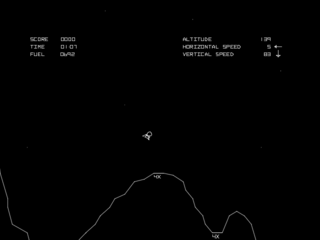Related Research Articles
A fourth-generation programming language (4GL) is any computer programming language that belongs to a class of languages envisioned as an advancement upon third-generation programming languages (3GL). Each of the programming language generations aims to provide a higher level of abstraction of the internal computer hardware details, making the language more programmer-friendly, powerful, and versatile. While the definition of 4GL has changed over time, it can be typified by operating more with large collections of information at once rather than focusing on just bits and bytes. Languages claimed to be 4GL may include support for database management, report generation, mathematical optimization, GUI development, or web development. Some researchers state that 4GLs are a subset of domain-specific languages.

A mainframe computer, informally called a mainframe or big iron, is a computer used primarily by large organizations for critical applications like bulk data processing for tasks such as censuses, industry and consumer statistics, enterprise resource planning, and large-scale transaction processing. A mainframe computer is large but not as large as a supercomputer and has more processing power than some other classes of computers, such as minicomputers, servers, workstations, and personal computers. Most large-scale computer-system architectures were established in the 1960s, but they continue to evolve. Mainframe computers are often used as servers.
PL/I is a procedural, imperative computer programming language developed and published by IBM. It is designed for scientific, engineering, business and system programming. It has been used by academic, commercial and industrial organizations since it was introduced in the 1960s, and is still used.

Turing is a high-level, general-purpose programming language developed in 1982 by Ric Holt and James Cordy, at University of Toronto in Ontario, Canada. It was designed in order to help students taking their first computer science course learn how to code. Turing is a descendant of Pascal, Euclid, and SP/k that features a clean syntax and precise machine-independent semantics.
In computer science, Backus–Naur form or Backus normal form (BNF) is a metasyntax notation for context-free grammars, often used to describe the syntax of languages used in computing, such as computer programming languages, document formats, instruction sets and communication protocols. It is applied wherever exact descriptions of languages are needed: for instance, in official language specifications, in manuals, and in textbooks on programming language theory.

R is a programming language for statistical computing and graphics supported by the R Core Team and the R Foundation for Statistical Computing. Created by statisticians Ross Ihaka and Robert Gentleman, R is used among data miners, bioinformaticians and statisticians for data analysis and developing statistical software. The core R language is augmented by a large number of extension packages containing reusable code and documentation.
Adabas, a contraction of “adaptable database system," is a database package that was developed by Software AG to run on IBM mainframes. It was launched in 1971 as a non-relational database. As of 2019, Adabas is marketed for use on a wider range of platforms, including Linux, Unix, and Windows.

The history of software configuration management (SCM) in computing can be traced back as early as the 1950s, when CM, originally for hardware development and production control, was being applied to software development. The first software configuration management was most likely done manually. Eventually, software tools were written to manage software changes. History records tend to be based on tools and companies, and lend concepts to a secondary plane.

CA Technologies, Inc., formerly Computer Associates International, Inc., and CA, Inc., was an American multinational enterprise software developer and publisher that existed from 1976 to 2018. CA grew to rank as one of the largest independent software corporations in the world, and at one point was the second largest. The company created systems software that ran in IBM mainframe, distributed computing, virtual machine, and cloud computing environments.

Lunar Lander is a genre of video games loosely based on the 1969 landing of the Apollo Lunar Module on the Moon. In Lunar Lander games, players generally control a spacecraft as it falls toward the surface of the Moon or other astronomical body, using thrusters to slow the ship's descent and control its horizontal motion to reach a safe landing area. Crashing into obstacles, hitting the surface at too high a velocity, or running out of fuel all result in failure. In some games in the genre, the ship's orientation must be adjusted as well as its horizontal and vertical velocities.
RPG is a high-level programming language for business applications, introduced in 1959 for the IBM 1401. It is most well known as the primary programming language of IBM's midrange computer product line, including the IBM i operating system. RPG has traditionally featured a number of distinctive concepts, such as the program cycle, and the column-oriented syntax. The most recent version is RPG IV, which includes a number of modernization features, including free-form syntax.

The Integrated Database Management System (IDMS) is a network model (CODASYL) database management system for mainframes. It was first developed at B.F. Goodrich and later marketed by Cullinane Database Systems. Since 1989 the product has been owned by Computer Associates, who renamed it Advantage CA-IDMS and later simply to CA IDMS.
Cullinet was a software company whose products included the database management system IDMS and the integrated software package Goldengate. In 1989, the company was bought by Computer Associates. Cullinet was headquartered at 400 Blue Hill Drive in Westwood, Massachusetts.
Basic Assembly Language (BAL) is the commonly used term for a low-level programming language used on IBM System/360 and successor mainframes. Originally, "Basic Assembly Language" applied only to an extremely restricted dialect designed to run under control of IBM Basic Programming Support (BPS/360) on systems with only 8 KB of main memory, and only a card reader, a card punch, and a printer for input/output — thus the word "Basic". However, the full name and the initialism "BAL" almost immediately attached themselves in popular use to all assembly-language dialects on the System/360 and its descendants. BAL for BPS/360 was introduced with the System/360 in 1964.

TELON, later renamed CA-TELON, is one of the first commercially successful application generators for building business applications.
Scientific Time Sharing Corporation (STSC) was a pioneering timesharing and consulting service company which offered APL from its datacenter in Bethesda, MD to users in the United States and Europe.

Applied Data Research (ADR) was a large software vendor from the 1960s until the mid-1980s. ADR is often described as "the first independent software vendor".
Computer Associates Panvalet is a revision control and source code management system originally developed by Pansophic Systems for mainframe computers such as the IBM System z and IBM System/370 running the z/OS and z/VSE operating systems.
Mainframe computers are computers used primarily by businesses and academic institutions for large-scale processes. Before personal computers, first termed microcomputers, became widely available to the general public in the 1970s, the computing industry was composed of mainframe computers and the relatively smaller and cheaper minicomputer variant. During the mid to late 1960s, many early video games were programmed on these computers. Developed prior to the rise of the commercial video game industry in the early 1970s, these early mainframe games were generally written by students or employees at large corporations in a machine or assembly language that could only be understood by the specific machine or computer type they were developed on. While many of these games were lost as older computers were discontinued, some of them were ported to high-level computer languages like BASIC, had expanded versions later released for personal computers, or were recreated for bulletin board systems years later, thus influencing future games and developers.
Pansophic Systems, Inc., or simply Pansophic, was a major American software company active from 1969 to 1991 and based in the Chicago metropolitan area. A pioneering software firm, it was among the first wave of independent software vendors in the late 1960s. Initially a supplier of source code and information management software for IBM mainframe computers with their flagship products Panvalet and Easytrieve, the company soon leaned into the minicomputer and personal computer markets, supplying application packages for many differing fields. The company was acquired by and absorbed into Computer Associates in October 1991 for nearly $300 million.
References

- ↑ Skidmore, Lem (25 June 1979). "Nonapplications: Preparation Vital". Computerworld . IDG Enterprise. 13 (26): SR/2 and SR/28. ISSN 0010-4841 . Retrieved 28 February 2021.
- ↑ Mace, Scott (21 March 1988). "Pansophic Adds Plain English Query Language to Easytrieve". InfoWorld . InfoWorld Media Group, Inc. 10 (12): 28. ISSN 0199-6649.
- 1 2 Piscopo, Joseph A. (2002-05-03). "Oral history interview with Joseph Piscopo": 16.
{{cite journal}}: Cite journal requires|journal=(help) - ↑ Bergin, Thomas J.; Haigh, Thomas (October 2009). "The Commercialization of Database Management Systems, 1969–1983". IEEE Annals of the History of Computing. 31 (4): 26–41. doi:10.1109/MAHC.2009.107. ISSN 1058-6180. S2CID 12367040.